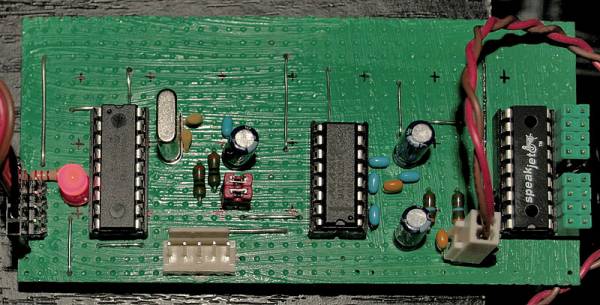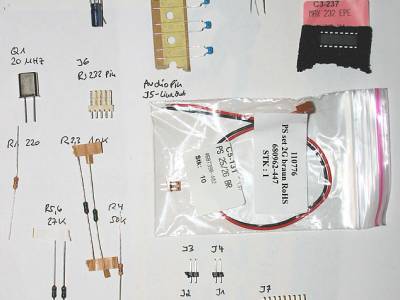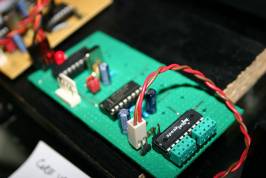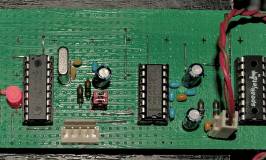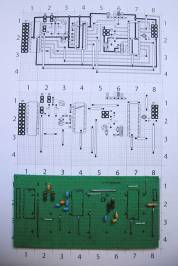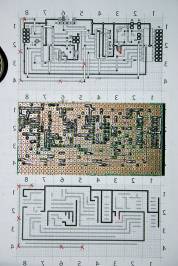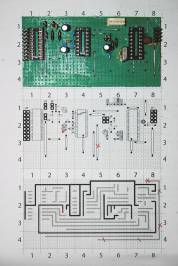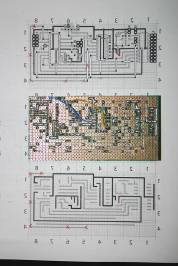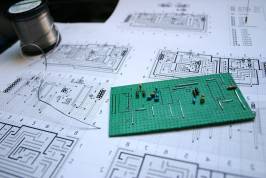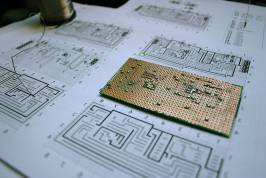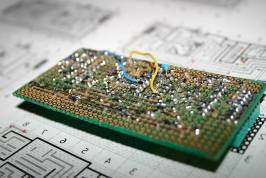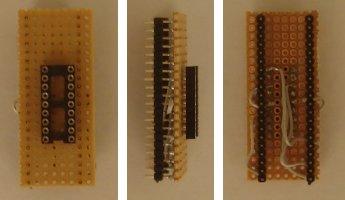Table of Contents
SpeakJet IIC Module Construction
1. Introduction
There are currently no etched boards or etching layouts available. But here's a detailed plan for a breadboard. Soldering that shouldn't take longer than soldering a premade one.
Download the PDF plan from below to get started, it contains also a list of needed parts. If you have FreeHand, you should definitely also download the source, because you can switch the visibility of layers. However, the PDF contains multiple views of the Breadboard Construction, so it should be easy to rebuild.
The RS232 Section is optional.


Because RS232 is operated with 12V and the SpeakJet just deals with 5V, you will likely damage it!
2. Hardware Setup
Full Setup
To turn the SpeakJet IIC Module into a fully operateable synthesizer, you need this:
- 1 Core-Module (PIC18F)
- 1 SpeakJet IIC Module (PIC16F, MAX232 and SpeakJet)
- optional 1 LCD
- optional Amplifier circuit
Construction Steps
- Soldering the core module
- Building the Speakjet iic module
- For Core V2 Users: Adding an additional 1k pull-up resistor between Vd and SC at CORE::J4 (to allow “clock stretching”, not needed for Core V3)
- Burning the speakjet_iic firmware to the PIC16F Microchip (requires a MBHP-Burner module together with a 18-to-40 pin adapter made out of two IC-Sockets)
- The Core runs with MIOS (default Bootloader), PIC18F Chips from SmashTV or Mike's Midishop are compatible!
3. Connections
You need to download the plan (it also contains a list of needed parts!):
- Preliminary Breadboard with lowPassFilter (PDF, 604 kB)
- Preliminary Breadboard with lowPassFilter (FreeHandMX sourcefile with a lot of nice electronical symbols and layer visibility toggles!, 264 kB)
4. Parts List
| Part | Value | Type | Qty | Mouser Ref |
|---|---|---|---|---|
| IC1 | SpeakJet | SpeakJet | 1 | / |
| IC2 | PIC 16F88 | PIC | 1 | 579-PIC16F88-I/P |
| IC3 | MAX 232 | MAX 232 EEPE | 1 | 700-MAX232EEPE |
| Q1 | 20MHz | Q | 1 | |
| R1 | 220 | Resistor | 1 | 291-220-RC |
| R2,R3 | 10k | Resistor | 2 | 291-10k-RC |
| R5,R6 | 27k | Resistor | 2 | 291-27k-RC |
| R4 | 27k | Resistor | 1 | 291-50k-RC |
| C1,C2 | 15pF | Capacitor Ceram | 2 | |
| C12,C13 | 10nF | Capacitor Ceram | 2 | |
| C4,C6-10 | 100nF | Capacitor Ceram | 5 | |
| C3,C5,C11 | 10µF/16V | Capacitor Elec | 3 |
Jumpers
- J1 IIC
- J2 ID
- J3 Line-Out (unfiltered)
- J41 1: SJ Out, 2: D0 (Ready), 3: D1 (Speaking)
- J5 Line-Out (hiPass-filtered)
- J6 RS232: PC I/O
- J7 SJ Event Inputs (see Datasheet!)
6. Buying Speakjet IC
7. Soldering the Board
The current board version v1.3 has a lot less backside cabling, is easier to solder, parts have all convenient sizes and the board dimensions are landscape; similar to the MBHP-DIN/DOUT PCBs.
Here is a Picture Gallery v1.3 that shows the process of soldering the breadboard along with some final pictures from different views. Picture Gallery v1.0 (for historic reasons only)
Don't cut the legs at once, use them to build the paths at the bottom!I tried to make the board as small as possible, but there should be enough space to add additional pins if necessary.
8. Burning the PIC16F Firmware
You'll need the MBHP-Burner and build an adaptor from 40pin to 18pin:
- http://www.ucapps.de/mbhp_iic_midi.html uCApps – among description of the adaptor, you will find useful informations (ID-Jumper, IIC…) on this side. read it!
- Schematic 18pin adaptor for Burner uCApps (PDF)
Set the burner to 13.1 V (for PIC16; if you're burning PIC18 use 12.5 V) I've heard that Mike is burning the PIC16 chips, maybe SmashTV will also do this service. Just ask in the forum!

Adding a Core Module
- Build a MBHP core module; I recommend using the double sided PCBs from SmashTV. They have a few extras that make life easier and the quality is pretty cool ;)
- Build a 4 pin ribbon cable with connectors.
- Connect the J4 pin row of the Core → to one row of J1 of the SJ-IIC-Module. there are two rows, because IIC modules and other IIC-Devices can be chained
- For kII v.0.2.4 and higher: connect SpeakJet:D2/BufferHalfFull to Core:J14 (optional)
- Upload MIOS v.1.9 to the Core
- Upload the kII application
